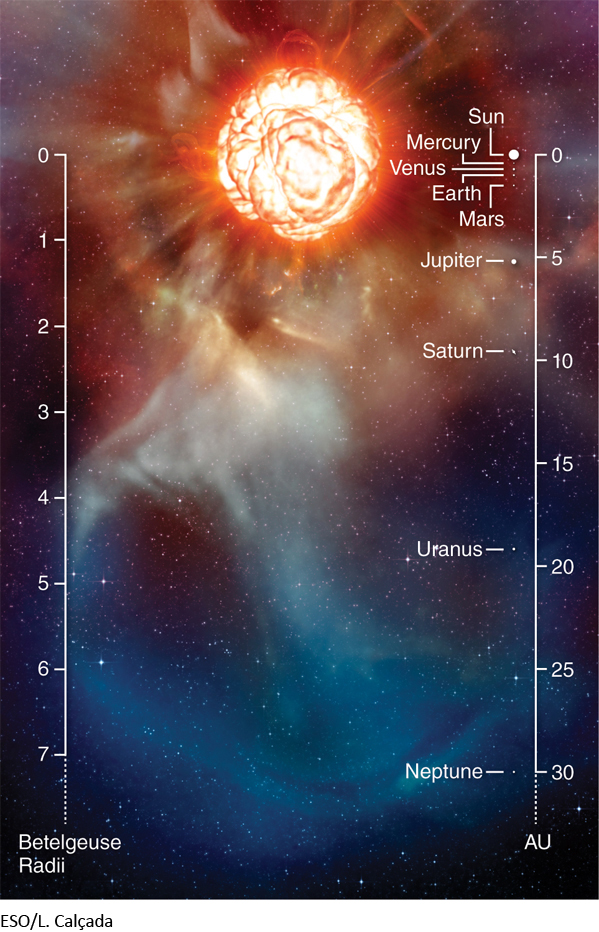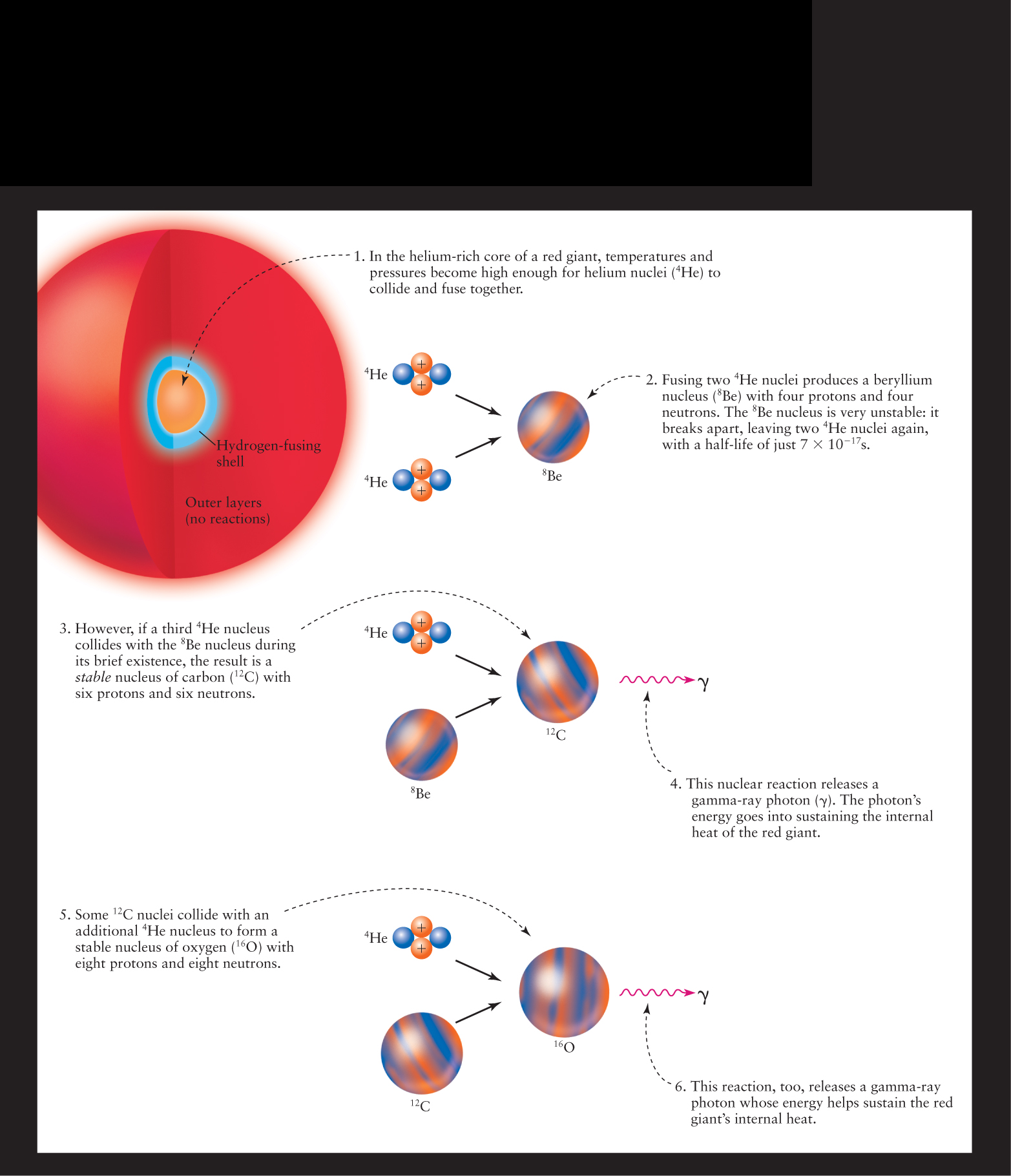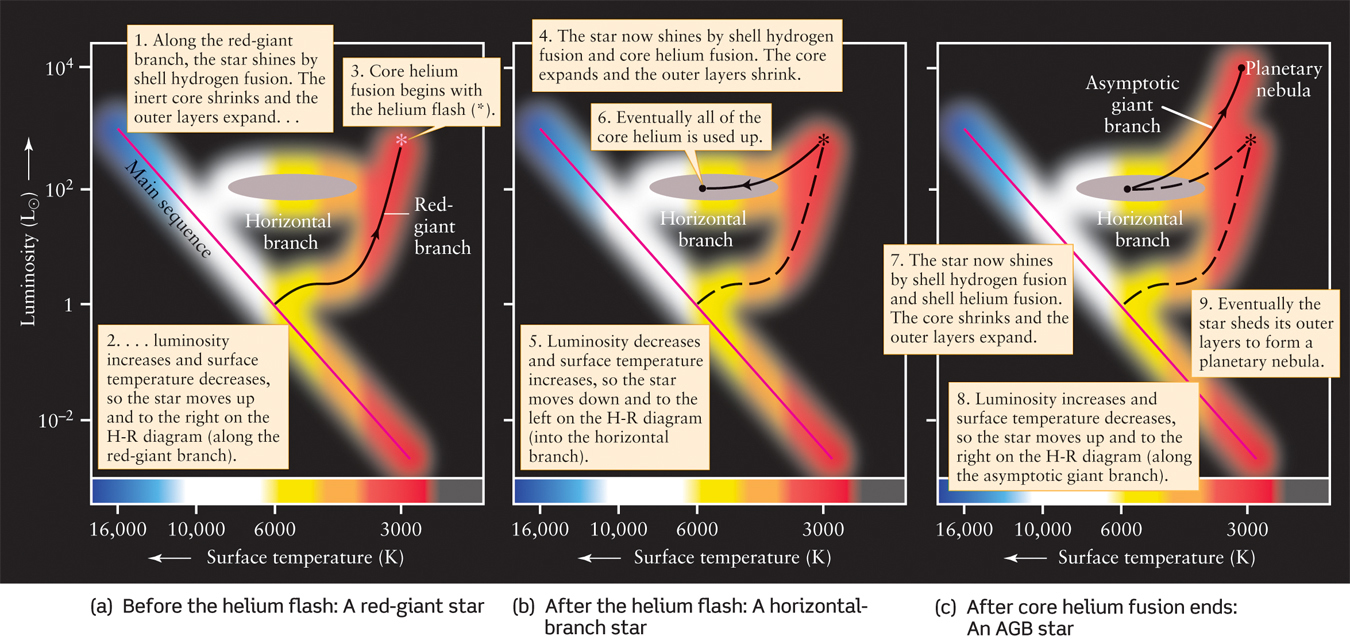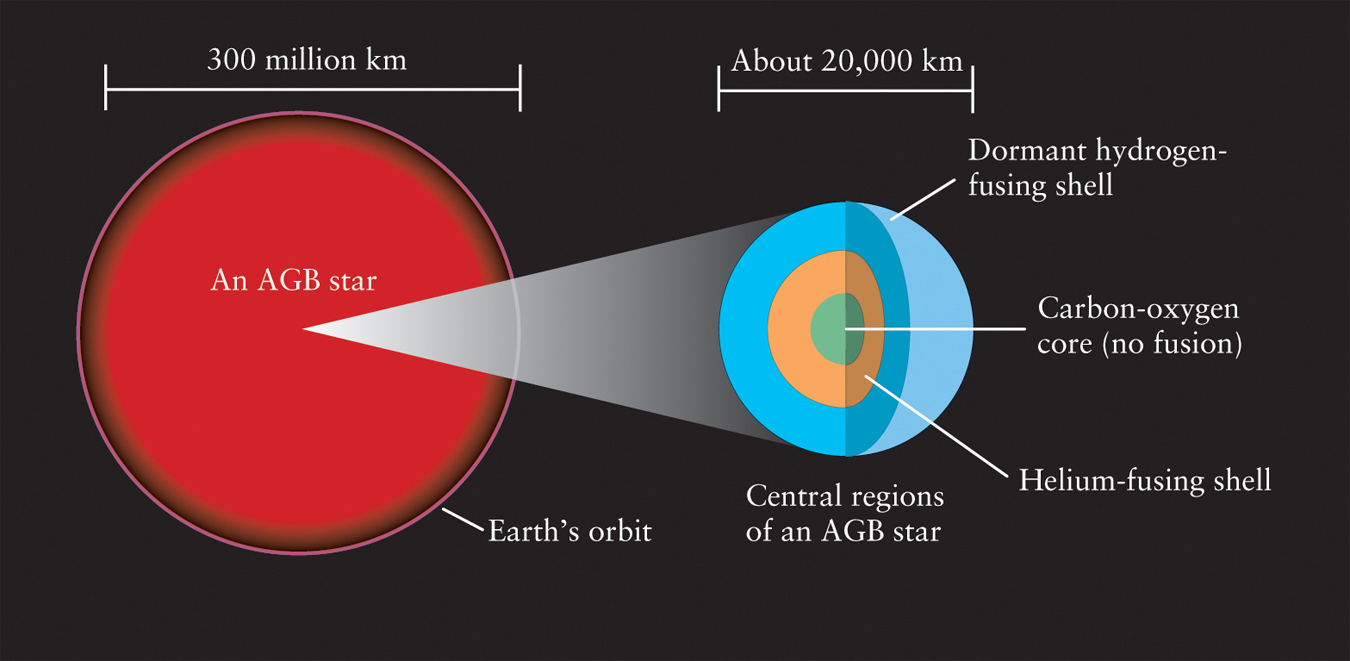11-4 Stars slowly become red giants
What is the fate of stars more massive than about 0.4 M⊙, including the Sun? As we will see, the late stages of their evolution are dramatic. Studying these stages will give us insight into the fate of our solar system and life on Earth.
Stars of 0.4 M⊙ or Greater: From Main-Sequence Star to Red Giant
The most massive stars consume their core fuel rapidly to support the extreme pressure from the overlying weight.
When a star of at least 0.4 solar masses reaches the end of its main-sequence lifetime, all of the hydrogen in its core has been used up and hydrogen fusion ceases there. In this new stage, hydrogen fusion continues only in the surrounding shell of hydrogen-rich material just outside the central core. At first, this process occurs only in the hottest region just outside the core, where the hydrogen fuel has not yet been exhausted. Outside this region, it is not hot enough for any fusion reactions to take place.
264
Strangely enough, the end of hydrogen fusion in the core increases the core’s temperature. When thermonuclear reactions first cease in the core, nothing remains to generate heat there. Hence, the core starts to cool and the pressure supporting the core starts to decrease. This pressure decrease allows the star’s core to again compress under the weight of the outer layers. As the core contracts, its temperature again increases, and heat begins to flow outward from the core even though no nuclear reactions are taking place there. (Technically, gravitational energy is converted into thermal energy.)
This new flow of heat warms the gases around the core, increasing the rate of hydrogen fusion surrounding the core and making the active shell eat further outward into the surrounding matter. Helium produced by reactions in the shell falls down onto the core, which continues to contract and heat up as it gains mass. Over the course of hundreds of millions of years, the core of a 1-M⊙ star compresses to about one-third of its original radius, while its central temperature increases from about 15 million (1.5 × 107) K to about 100 million (108) K.
During this post–main-sequence phase, the star’s outer layers expand just as dramatically as the core contracts. As the hydrogen-fusing shell works its way outward, egged on by heat from the contracting core, the star’s luminosity increases substantially. This increases the star’s internal pressure and makes the star’s outer layers expand to many times their original radius. This tremendous expansion causes those layers to cool down, and the star’s surface temperature drops. Once the temperature of the star’s bloated surface falls, the gases glow with a reddish hue. Based on its new appearance, the star is then appropriately known as a red giant (Figure 11-18). Thus, we see that red-giant stars are former main-sequence stars that have evolved into a new stage of existence. We can summarize these observations as a general rule:
Stars join the main-sequence group when they begin hydrogen fusion in their cores. They leave the main-sequence group and become giant stars when their core hydrogen is depleted.

Red-giant stars undergo substantial loss of their mass because of their large diameters and correspondingly weak surface gravity. This makes it relatively easy for gases to escape from the red giant into space. Mass loss can be detected in a star’s spectrum, because gas escaping from a red giant toward a telescope on Earth produces narrow absorption lines that are slightly blueshifted by the Doppler effect. Typical observed blueshifts correspond to a speed of about 22,000 mi/h (10 km/s). A typical red giant loses roughly 10−7 M⊙ of matter per year. For comparison, the Sun’s present-day mass-loss rate is only 10−14 M⊙ per year. Hence, an evolving star loses a substantial amount of mass as it ages (see Figure 11-17).
Question
ConceptCheck 11-10: Why does a red giant appear red if it is cool?
Fusion of Helium into Carbon and Oxygen Begins at the Center of a Red Giant
When a star with a mass greater than 0.4 M⊙ first changes from a main-sequence star (Figure 11-19a) to a red giant (Figure 11-19b), its hydrogen-fusing shell surrounds a small, compact core of almost pure helium. In a red giant of moderately low mass, which the Sun will become 7 billion years from now, the dense helium core is about twice the diameter of Earth. Most of this core helium was produced by thermonuclear reactions during the star’s main-sequence lifetime; during the red-giant era, this helium will undergo thermonuclear reactions.

265
Helium, the “ash” left over from hydrogen fusion, is a potential nuclear fuel, and the thermonuclear fusion of helium nuclei to make even heavier nuclei releases energy in the process. But this reaction cannot take place within the core of our present-day Sun because the temperature there is far too low. Each helium nucleus contains two protons, so it has twice the positive electric charge of a hydrogen nucleus, and there is a much stronger electric repulsion between two helium nuclei than between two hydrogen nuclei. For helium nuclei to overcome this repulsion and get close enough to fuse together, they must be moving at very high speeds, which means that the temperature of the helium gas must be very high.
When a star first becomes a red giant, the temperature of the contracted helium core is still too low for helium nuclei to fuse. But as the hydrogen-fusing shell adds mass to the helium core, the core contracts even more, further increasing the star’s central temperature. When the central temperature finally reaches 100 million (108) K, thermonuclear fusion of helium in the core begins. As a result, the aging star again has a new central energy source for the first time since leaving the main sequence.
Helium fusion combines helium atoms to form carbon in a new process that releases energy that fuels the star’s core. This process uses three helium atoms to form carbon and is called the triple alpha process, because helium nuclei (4He) are also called alpha particles. Some of the carbon created in this process can go on to fuse with additional helium to produce a stable isotope of oxygen and release even more energy (see Cosmic Connections: Helium Fusion in a Red Giant).
The nuclear fusion processes of helium release tremendous amounts of energy, even more than hydrogen fusion. The onset of these reactions reestablishes stability in the star’s core and prevents any further gravitational contraction of the star’s core. Curiously, a mature red giant fuses helium in its core for a much shorter time than it spent fusing hydrogen in its core as a main-sequence star. For example, in the distant future the Sun will sustain helium fusion in its core for only about 100 million years. (While this is going on, hydrogen fusion is still continuing in a shell around the core.)
Question
ConceptCheck 11-11: What is different about the core of a red giant that allows helium to fuse when it cannot occur in the core of our present-day Sun?
The Helium Flash and Electron Degeneracy
Precisely how helium fusion begins at a red giant’s center depends on the mass of the star. In high-mass red giants (greater than about 2 to 3 M⊙), helium fusion begins gradually as temperatures in the star’s core approach 108 K. In red giants with a mass less than about 2 to 3 M⊙, helium fusion begins explosively and suddenly, in what is called the helium flash. Table 11-2 summarizes these differences.
| Mass of star | Onset of helium fusion |
|---|---|
| More than about 0.4 but less than 2–3 M⊙ | Explosive (helium flash) |
| More than 2–3 M⊙ | Gradual |
The helium flash occurs because of unusual conditions that develop in the core of a moderately low-mass star as it becomes a red giant. To appreciate these conditions we must first understand how an ordinary gas behaves, then we can explore how the densely packed electrons at the star’s center alter this behavior.
When a gas is compressed, it usually becomes denser and warmer. In fact, for gas like air on Earth, there is a relatively simple relationship between pressure, temperature, and density. Specifically, the pressure exerted by a gas on its container is directly proportional to both the density and the temperature of the gas. In most circumstances, the gases inside a star behave in this way. If the gas expands, it cools down, and if it is compressed, it heats up. This behavior serves as a safety valve, ensuring that the star remains in a stable thermal equilibrium. For example, if the rate of thermonuclear reactions in the star’s core should increase, the additional energy releases heat and expands the core. This cools the core’s gases and slows the rate of thermonuclear reactions back to the original value. Conversely, if the rate of thermonuclear reactions should decrease, the core will cool down and compress under the pressure of the overlying layers. The compression of the core will make its temperature increase, thus speeding up the thermonuclear reactions and returning them to their original rate.
In a red giant with a mass between about 0.4 M⊙ and 2–3 M⊙, however, the core behaves very differently than the way just described. In a red giant, the core must be compressed tremendously in order to become hot enough for helium fusion to begin. At these extreme pressures and temperatures, the atoms are stripped of their electrons and become completely ionized. As a result, most of the core consists of atomic nuclei and detached electrons. Eventually, the free electrons become so closely crowded that a limit to further compression is reached. Just before the onset of helium fusion, the electrons in the core of a low-mass star are so closely crowded together that they cannot be squeezed any closer together and they produce a powerful pressure that resists any further core contraction.
266
COSMIC CONNECTIONS Helium Fusion in a Red Giant
A star becomes a red giant after the fusion of hydrogen into helium in its core has come to an end. As the red giant’s core shrinks and heats up, a new cycle of reactions can occur that create the even heavier elements carbon and oxygen.

267
This phenomenon is called degeneracy. Astronomers say that the electrons in the helium-rich core of a low-mass red giant are “degenerate,” and that the core is supported by degenerate-electron pressure. This degenerate pressure, unlike the more typical gas pressure, does not depend on temperature. When the temperature in the core of a low-mass red giant reaches the high level required for the triple alpha process, energy begins to be released. The helium heats up, which makes the triple alpha process happen even faster. However, the pressure provided by the degenerate electrons is independent of the temperature, so the pressure does not change. Without the “safety valve” of increasing pressure, the star’s core cannot expand and cool. The rising temperature causes the helium to fuse at an ever-increasing rate, producing the helium flash.
Eventually, the temperature becomes so high that the electrons in the core are no longer degenerate. Then, when the star’s core expands, the helium flash is terminated. These events occur so rapidly that the helium flash is over in seconds, after which the star’s core settles down to a steady rate of helium fusion.
CAUTION
The term “helium flash” might give the impression that a star emits a sudden flash of light when the helium flash occurs. If this were true, it would be an incredible sight. During the brief time interval when the helium flash occurs, the helium-fusing core is 1011 times more luminous than the present-day Sun, comparable to the total luminosity of all the stars in the Milky Way Galaxy! But in fact, the helium flash has no immediately visible consequences—for two reasons. First, much of the energy released during the helium flash goes into heating the core and terminating the degenerate state of the electrons. Second, the energy that does escape the core is largely absorbed by the star’s outer layers, which are quite opaque. Therefore, the explosive drama of the helium flash takes place where it cannot be seen directly.
Question
ConceptCheck 11-12: If a core of degenerate electrons actually depended on temperature, how would it respond to an increase in temperature?
The Continuing Evolution of a Red Giant
Whether a helium flash occurs or not, the onset of helium fusion in the core actually causes a decrease in the luminosity of the star. This is the opposite of what you might expect—after all, turning on a new energy source should make the luminosity greater, not less. What happens is that after the onset of core helium fusion, a star’s superheated core expands. Temperatures drop around the expanding core, so the surrounding shell of hydrogen fusion reduces its energy output and the star’s overall energy output decreases. This allows the star’s outer layers to contract and heat up. Consequently, a post–helium-flash star is less luminous, hotter at the surface, and smaller than a red giant.
Helium fusion occurring in the core lasts for only a relatively short time. Calculations suggest that a 1-M⊙ star like the Sun sustains hydrogen fusion in its core for about 12 billion (1.2 × 1010) years, followed by about 250 million (2.5 × 108) years of hydrogen fusion in the shell surrounding the core leading up to the helium flash. After the helium flash, such a star can fuse helium in its core (while simultaneously fusing hydrogen in a shell around the core) for only 100 million (108) years, a mere 1% of its main-sequence lifetime. Here is the story of post–main-sequence evolution in its briefest form: Before the beginning of helium fusion in the core, the star’s core compresses and the outer layers expand, and just after helium fusion begins, the core expands and the outer layers compress. We will see in the next chapter that this behavior, in which the inner and outer regions of the star change in opposite ways, occurs again and again in the final stages of a star’s evolution.
Question
ConceptCheck 11-13: Why is a star fueled by a hotter core of helium fusion less luminous?
Stars of Between 0.4 M⊙ and 4 M⊙ Go Through Two Distinct Red-Giant Stages
 Go to Video 11-5
Go to Video 11-5
It is worth emphasizing again that the difference in the final chapters of a star’s life cycle primarily depends on one characteristic—the star’s mass. Main-sequence stars convert hydrogen to helium in their cores in a series of energy-releasing thermonuclear reactions, but the specific details depend on mass. Let’s examine next what happens to a star of moderately low mass, between 0.4 M⊙ and 4 M⊙. One example of such a star is our own Sun, with a mass of 1 M⊙. (Our discussion of the largest stars is in the next chapter.)
We can describe a Sunlike star’s post–main-sequence evolution using an evolutionary track on an H-R diagram. Figure 11-20 shows the track for a 1-M⊙ star like the Sun. When an aging star first becomes a red giant, the luminosity increases and the surface temperature drops, the post–main-sequence star moves up and to the right along a red-giant branch on an H-R diagram (Figure 11-20a).

Next, the helium-rich core of the star shrinks and heats until eventually helium fusion begins in the core. This causes the core to expand, which in turn makes the core cool down a bit. The cooling of the core also cools the surrounding hydrogen-fusing shell, so that the shell releases energy more slowly. Hence, the luminosity goes down a bit after core helium fusion begins.
268
The slower rate of energy release also lets the star’s outer layers contract. As they contract, they heat up, so the star’s surface temperature increases and its evolutionary track moves to the left on the H-R diagram (Figure 11-20b). The luminosity changes relatively little during this stage, so the evolutionary track on the H-R diagram moves almost horizontally. These horizontal-branch stars have helium-fusing cores surrounded by hydrogen-fusing shells.
Question
ConceptCheck 11-14: Are horizontal-branch red-giant stars becoming more or less luminous?
AGB Stars: The Second Red-Giant Stage
Helium fusion produces nuclei of carbon and oxygen. After about 100 million (108) years of helium fusion in the core, essentially all the core helium of a 1-M⊙ star has been converted into carbon and oxygen, and the fusion of helium in the core ceases. Without thermonuclear reactions to maintain the core’s internal pressure, the core again contracts, until it is stopped by degenerate-electron pressure. This contraction releases heat into the surrounding helium-rich gases, and a new stage of helium fusion begins in a thin shell around the core.
History now repeats itself—the star enters a second red-giant phase. A star first becomes a red giant at the end of its main-sequence lifetime, when the outpouring of energy from hydrogen fusion in the shell surrounding the core makes the star’s outer layers expand and cool. In the same way, the outpouring of energy from shell helium fusion causes the outer layers to expand again. The low-mass star ascends into the red-giant region of the H-R diagram for a second time (Figure 11-20c), but now with even greater luminosity than during its first red-giant phase.
Stars in this second red-giant phase are commonly called asymptotic giant branch stars, or AGB stars, and their evolutionary tracks approach the red-giant branch from the left on an H-R diagram. When a low-mass star first becomes an AGB star, it consists of an inert, degenerate carbon-oxygen core and a surrounding shell of helium fusion, both inside a surrounding shell of hydrogen fusion, all within a volume not much larger than Earth. This small, dense central region is surrounded by an enormous hydrogen-rich envelope about as big as Earth’s orbit around the Sun. After a while, the expansion of the star’s outer layers causes the layers of hydrogen fusion to also expand and cool, and thermonuclear reactions in this shell temporarily cease. This leaves the aging star’s structure as shown in Figure 11-21.

Remember, the shorter the amount of time it remains on the main sequence, the faster the star will go through these stages. Similarly, the greater the star’s mass, the more rapidly it goes through the stages of post–main-sequence evolution. Hence, we can see all of these stages by studying clusters of stars, which contain stars that are all the same age but that have a range of masses. Figure 11-22 shows an H-R diagram for the globular cluster M55, which is at least 13 billion years old. The least massive stars in this cluster are still on the main sequence. Progressively more massive stars have evolved to the red-giant branch, the horizontal branch, and the asymptotic giant branch.

269
A 1-M⊙ AGB star can reach a maximum luminosity of nearly 104 L⊙, as compared with approximately 103 L⊙ when it reached the helium flash and a relatively paltry 1 L⊙ during its main-sequence lifetime. When the Sun becomes an AGB star some 12.3 billion years from now, this tremendous increase in luminosity will cause the planet Mars and the Jovian planets to largely evaporate away. The Sun’s bloated outer layers will reach to Earth’s orbit. Mercury and perhaps Venus will simply be swallowed whole.
Question
ConceptCheck 11-15: When the Sun becomes an AGB star, will Earth’s orbit be inside the core?